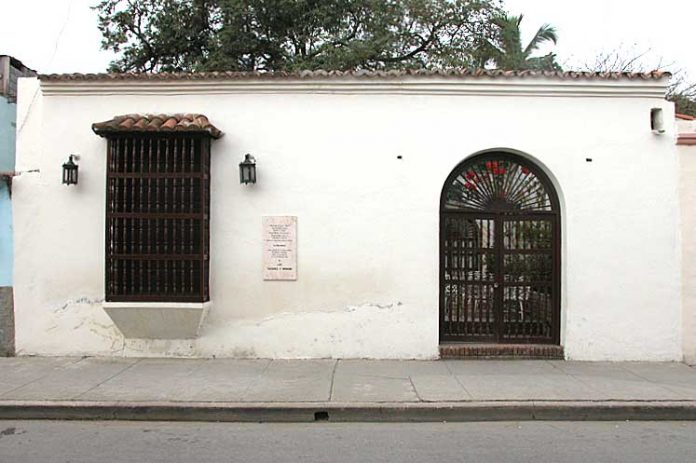
Contents
Luz Vazquez was a beautiful woman, inspiring the theme La Bayamesa, romantic founder of the Cuban trova song.
The so called Window of Luz Vazquez is part of the urban center of Bayamo City, in the eastern province of Granma. The window belongs to the place where Luz Vazquez y Moreno lived, inspiring woman who served as inspiration for the first Cuban troubadour romantic song, “The Bayamesa” sung for the first time on March 27th, 1851.
Location of Window of Luz Vazquez
The window is located in 160 Carlos Manuel de Cespedes Street, between Perucho Figueredo and Lora streets, in Christ Neighborhood. It bounds on the north and east with homes, south with Maximo Gomez Street and west with San Salvador Church of Bayamo.
Description of Window of Luz Vazquez
This commemorative building is made with brick walls, entrance door and window with wooden bars. It has a dimension of 15 per 100 square meters.
History of Window of Luz Vazquez
In 1851 there lived in San Salvador Street (now called Cespedes), the marriage of Luz Vazquez y Moreno, and Francisco del Castillo. It was considered a good marriage, loved and respected by his friends and neighbors. They had seven children in total: Pompeyo, Francisco, Lucila, Heliodoro, Leonela, Atala and Adriana del Castillo.
On October 10th, 1868, Carlos Manuel de Cespedes started the first emancipating against the Spanish metropolis. Castillo Moreno and his heroic wife Luz Vazquez were among the first cooperators of the liberator company. On the same day of the Seize of Bayamo, still heartbroken pain by the recent funeral of Pompeyo, one of the children of the marriage, the vast halls of the stately mansion opened to celebrate the Cuban victory.
When Bayamo was about to be re-taken by the Spanish forces, the citizens decided to burn their city rather than see it fall into enemy hands. Luz Vazquez with his own hands set fire to his house, which was one of the first mansions burn and ended in ruins. Currently in this place lies the headquarters of the Union of Writers and Artists of Cuba of Bayamo.
Facts about Luz Vazquez
Luz Vazquez and Moreno was born in Bayamo in the year 1831, within a wealthy family that had separatist sentiments. Tall, thin, swarthy skin and deep black and vivacious eyes, was considered in 1851, at the age of twenty, one of the most prominent beauties of the time.
Luz already married with Francisco del Castillo, at the beginning of the independence struggle October 1868, the husband went to the insurrectionary countryside with his son Francisco. Luz, who watched his son Pompeyo die the same day of Seize of Bayamo, received after, the fatal news of the death of his son Francisco, and mourning and in pain, but determined, harangued Atala, one of her daughters, so she went to sing the anthem of Perucho Figueredo next to “Canducha” Figueredo.
Absent husband, two sons dead, Luz went for the immense pain of seeing sick from tuberculosis his daughter Lucilla. Lost loved ones, as well as property and fortune turned into debris, a fire with her own hands to the house in the fire of Bayamo; Luz Vazquez, accompanied by Adriana and helped by the rest of her offspring, supported the work of insurrection. It is said that Francisco Vicente Aguilera, the patriot, claimed “she was a jewel of inestimable value.”
Bayamo, became a mound of ruins, it housed several families returned harassed by the Spaniards to take refuge in the remains of houses blackened by smoke. One of those holes, in San Francisco Street, in the garage of what had been her aristocratic home, came Luz Vazquez with his daughter Adriana, who was almost dying, burning with fever of typhus that tore the existence and Lucila transfixed by the terrible tuberculosis.
Adriana succumbed by syncope, but not before refusing to be attended by a Spanish doctor and after singing the anthem of Bayamo. Adriana dead, all the attention went to Lucila, whose illness, shaken by so many emotions, advanced significantly. Tuberculosis had destroyed his lungs. Under these conditions, one night she fell into a severe attack of hemoptysis, after which she lost consciousness. A Spanish doctor, grieved for the misfortunes that occurred to this family, tried in vain to revive her. Suddenly called by the Count of Valmaseda, he had to leave the sick. The mother, from that moment, shocked and weeping, knelt beside the bed where she finally died, hugging the body of her daughter. Thus the life of Luz Vazquez ended, martyr in the history of Bayamo, and inspiring one of the most beautiful musical pages of colonial life.
Serenata in front of the Window of Luz Vazquez.
Some aspects of the event that gave rise to the famous musical composition are to be investigated; but it is certain that due to misunderstandings between the pair of Luz and Francisco, a day Luz was upset and Francisco wanted to make peace, so he asked Carlos Manuel de Cespedes and Jose Fornaris help him to sing his love and conquer it again.
Among Cespedes, Castillo and Fornaris composed the words and music of “The Bayamesa” which was sung on the night of March 27, 1851 before the closed window in the house of Luz, by the tenor Carlos Perez, accompanied by a guitar, while Francisco expected her to open the window. Curiosity and attention took over the neighborhood, even when she looked smiling and happy, for those sweet, passionate, vehement and very sad notes touched her tender heart.







